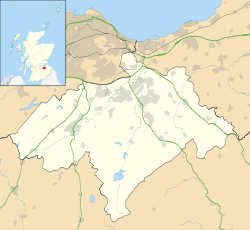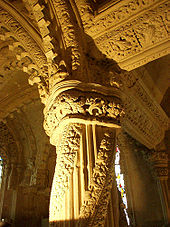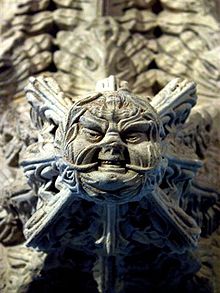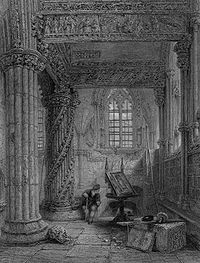- Rosslyn Chapel
-
Rosslyn Chapel 
Rosslyn ChapelShown within Midlothian 55°51′19″N 3°09′29″W / 55.85528°N 3.15806°WCoordinates: 55°51′19″N 3°09′29″W / 55.85528°N 3.15806°W OS grid reference NT275630 Location Roslin, Midlothian Country Scotland Denomination Scottish Episcopal Church Previous denomination Roman Catholic Website www.rosslynchapel.org.uk History Dedication Saint Matthew Rosslyn Chapel, properly named the Collegiate Chapel of St Matthew, was founded on a small hill above Roslin Glen as a Roman Catholic collegiate church (with between 4 and 6 ordained canons and two boy choristers) in the mid-15th century. Rosslyn Chapel and the nearby Roslin Castle are located at the village of Roslin, Midlothian, Scotland.
The chapel was founded by William Sinclair, 1st Earl of Caithness (also spelled "Sainteclaire/Saintclair/Sinclair/St. Clair") of the Sinclair family, a noble family descended from Norman knights from the commune of Saint-Clair-sur-Epte in northern France, using the standard designs the mediaeval architects made available to him. Rosslyn Chapel is the third Sinclair place of worship at Roslin - the first being in Roslin Castle and the second (whose crumbling buttresses can still be seen today) in what is now Roslin Cemetery.[1]
The purpose of the college was to celebrate the Divine Office throughout the day and night and also to celebrate Holy Mass for all the faithful departed, including the deceased members of the Sinclair family. During this period the rich heritage of plainsong (a single melodic line) or polyphony (vocal harmony) would be used to enrich the singing of the liturgy. An endowment was made that would pay for the upkeep of the priests and choristers in perpetuity and they also had parochial responsibilities.
After the Scottish Reformation (1560) Roman Catholic worship in the Chapel was brought to an end, although the Sinclair family continued to be Roman Catholics until the early 18th century. From that time the Chapel was closed to public worship until 1861 when it was opened again as a place of worship according to the rites of the Scottish Episcopal Church.
In later years the Chapel has featured in speculative theories regarding Freemasonry and the Knights Templar. An extensive programme of conservation is currently underway.
Contents
Architecture
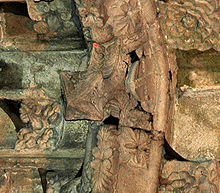 Pendant keystone in the roof
Pendant keystone in the roof
The original plans for Rosslyn have never been found or recorded, so it is open to speculation whether or not the chapel was intended to be built in its current layout. Its architecture is considered to be some of the finest in Scotland.[2]
Construction of the chapel began on 20 September 1456, although it is often been recorded as 1446. The confusion over the building date comes from the chapel's receiving its founding charter to build a collegiate chapel in 1446 from Rome. Sinclair did not start to build the chapel until he had built houses for his craftsmen. Although the original building was to be cruciform in shape, it was never completed; only the choir was constructed, with the retro-chapel, otherwise called the Lady chapel, built on the much earlier crypt (Lower Chapel) believed to form part of an earlier castle. The foundations of the unbuilt nave and transepts stretching to a distance of 90 feet were recorded in the 19th century. The decorative carving was executed over a forty-year period. After the founder's death, construction of the planned nave and transepts was abandoned - either from lack of funds, lack of interest or a change in liturgical fashion. The Lower Chapel (also known as the crypt or sacristy) should not be confused with the burial vaults that lie underneath Rosslyn Chapel.[1]
The chapel stands on fourteen pillars, which form an arcade of twelve pointed arches on three sides of the nave. At the east end, a fourteenth pillar between the penultimate pair form a three-pillared division between the nave and the Lady chapel.[3] The three pillars at the east end of the chapel are named, from north to south: the Master Pillar, the Journeyman Pillar, and most famously, the Apprentice Pillar. These names for the pillars date from the late Georgian period — prior to this period they were called The Earl's Pillar, The Shekinah and the Prince's pillar.
Apprentice pillar
The "Apprentice Pillar", or "Prentice Pillar", gets its name from a legend dating from the 18th century involving the master mason in charge of the stonework in the chapel and his young apprentice. According to the legend, the master mason did not believe that the apprentice could perform the complicated task of carving the column without seeing the original which formed the inspiration for the design. The master mason travelled to see the original himself, but upon his return was enraged to find that the upstart apprentice had completed the column anyway. In a fit of jealous anger the mason took up his mallet and struck the apprentice on the head, killing him. The legend concludes that as punishment for his crime, the master mason's face was carved into the opposite corner to forever gaze upon his apprentice's pillar.[4]
The pillar is also referred to as the "Princes Pillar" in An Account of the Chapel of Roslin (1778).
On the architrave joining the pillar there is the inscription Forte est vinum fortior est rex fortiores sunt mulieres super omnia vincit veritas: "Wine is strong, a king is stronger, women are stronger still, but truth conquers all" (1 Esdras, chapters 3 & 4).
Author Henning Klovekorn has proposed that the pillar is representative of one of the roots of the Nordic Yggdrasil tree, prominent in Germanic and Norse mythology. He compares the dragons at the base of the pillar to the dragons found eating away at the base of the Yggdrasil root and, pointing out that at the top of the pillar is carved tree foliage, argues that the Nordic/Viking association is plausible considering the many auxiliary references in the chapel to Celtic and Norse mythology.[5]
'Musical' boxes
Among Rosslyn's many intricate carvings are a sequence of 213 cubes or boxes protruding from pillars and arches with a selection of patterns on them. It is unknown whether these patterns have any particular meaning attached to them—many people have attempted to find information coded into them, but no interpretation has yet proven conclusive.
One recent attempt to make sense of the boxes has been to interpret them as a musical score. The motifs on the boxes somewhat resemble geometric patterns seen in the study of cymatics. The patterns are formed by placing powder upon a flat surface and vibrating the surface at different frequencies. By matching these Chladni patterns with musical notes corresponding to the same frequencies, the father-and-son team of Thomas and Stuart Mitchell produced a tune which Stuart calls the Rosslyn Motet.[6][7]
Green men
Another notable feature of Rosslyn's architecture is the presence of 'Green Men'. These are carvings of human faces with greenery all around them, often growing out of their mouths. They are commonly thought to be a symbol of renewal and fertility, pre-Christian in origin. In Rosslyn they are found in all areas of the chapel, with one excellent example in the Lady Chapel, between the two middle altars of the east wall. The green men in Rosslyn symbolise the months of the year in progression from East to West in the Chapel.[citation needed] Young faces are seen in the East symbolising Spring and as we progress towards the setting sun in the west the carvings age as in autumn of man's years. There are in excess of 110 carvings of Green men in and around the Chapel.
Plants
The authors Robert Lomas and Christopher Knight believe some carvings to be ears of new world corn or maize in the chapel.[8] This crop was unknown in Europe at the time of the chapel's construction, and was not cultivated there until several hundred years later. Knight and Lomas view these carvings as evidence supporting the idea that Henry I Sinclair, Earl of Orkney, travelled to the Americas well before Columbus. Mediaeval scholars interpret these carvings as stylised depictions of wheat, strawberries or lilies.[9]
Crypt
The Chapel has also acted as a burial place for several generations of the Sinclairs — a crypt was once accessible from a descending stair at the rear of the chapel. This crypt has for many years been sealed shut, which may explain the recurrent legends that it is merely a front to a more extensive subterranean vault containing (variously) the mummified head of Jesus Christ,[10] the Holy Grail,[11] the treasure of the Templars,[12] or the original crown jewels of Scotland.[13] In 1837 when the 2nd Earl of Rosslyn died, his wish was to be buried in the original vault; exhaustive searches over the period of a week were made, but no entrance to the original vault was found and he was buried beside his wife in the Lady Chapel.[14]
Rooftop pinnacle
The pinnacles on the rooftop have been subject to interest in 2010 during renovation work. Nesting Jackdaws had made the pinnacles unstable and as such had to be dismantled brick by brick revealing the existence of a chamber specifically made by the stonemasons to harbour bees. The hive, now abandoned has been sent to local bee keepers to identify.[15]
Conservation programme
The Chapel is currently undergoing an extensive programme of conservation. This includes work to the roof, the stone, the carvings, the stained glass and the organ.[16] A steel canopy was erected over the chapel roof for 14 years. This was to prevent further rain damage to the church and also to give it a chance to dry out properly. Major stonework repairs are due for completion by the end of 2011. The last major scaffolding was removed in August 2010.[17]
A new visitor centre is due to open in July 2011. The chapel's stained-glass windows and organ will be fully restored. New lighting and heating is being installed.[17]
The expected cost of the restoration work is around £13 million, with about £3.7 million being spent on the Visitor Centre. Funding has come from various sources including Heritage Lottery Fund, Historic Scotland and the environmental body, WREN. Actor Tom Hanks also made a donation.[17]
Templar and Masonic connections
The chapel, built 150 years after the dissolution of the Knights Templar, supposedly has many Templar symbols, such as the "Two riders on a single horse" that appear on the Seal of the Knights Templar.
As early as 2000 serious doubt was cast on any connection between Freemasonry and Rosslyn Chapel by the Curator of the Grand Lodge of Scotland Museum and Library, Robert L. D. Cooper, who has written several books on the subject.
The claim that the layout of Rosslyn Chapel echoes that of Solomon's Temple[18] has been analysed by Mark Oxbrow and Ian Robertson in their book, Rosslyn and the Grail:
Rosslyn Chapel bears no more resemblance to Solomon's or Herod's Temple than a house brick does to a paperback book. If you superimpose the floor plans of Rosslyn Chapel and either Solomon's or Herod's Temple, you will actually find that they are not even remotely similar. Writers admit that the chapel is far smaller than either of the temples. They freely scale the plans up or down in an attempt to fit them together. What they actually find are no significant similarities at all. [...] If you superimpose the floor plans of Rosslyn Chapel and the East Quire of Glasgow Cathedral you will find a startling match: the four walls of both buildings fit precisely. The East Quire of Glasgow is larger than Rosslyn, but the designs of these two mediaeval Scottish buildings are virtually identical. They both have the same number of windows and the same number of pillars in the same configuration. [...] The similarity between Rosslyn Chapel and Glasgow's East Quire is well established. Andrew Kemp noted that 'the entire plan of this Chapel corresponds to a large extent with the choir of Glasgow Cathedral' as far back as 1877 in the Proceedings of the Society of Antiquaries. Many alternative history writers are well aware of this but fail to mention it in their books.[9]
With regards to a possible connection between the St. Clairs and the Knights Templar, the family testified against the Templars when that Order was put on trial in Edinburgh in 1309.[9] Historian Dr. Louise Yeoman, along with other mediaeval scholars, says the Knights Templar connection is false, and points out that Rosslyn Chapel was built by William Sinclair so that Mass could be said for the souls of his family.[19]
It is also claimed that other carvings in the chapel reflect Masonic imagery, such as the way that hands are placed in various figures. One carving may show a blindfolded man being led forward with a noose around his neck—similar to the way a candidate is prepared for initiation into Freemasonry. The carving has been eroded by time and pollution and is difficult to make out clearly. The chapel was built in the 15th century, and the earliest records of Freemasonic lodges date back only to the late 16th and early 17th centuries.[20] A more likely explanation however is that the Masonic imagery was added at a later date. This may have taken place in the 1860s when James St Clair-Erskine, 3rd Earl of Rosslyn instructed Edinburgh architect David Bryce, a known freemason, to undertake restoration work on areas of the church including many of the carvings.[21]
William Sinclair 3rd Earl of Orkney, Baron of Roslin and 1st Earl of Caithness, claimed by novelists to be a hereditary Grand Master of the Scottish stonemasons, built Rosslyn Chapel.[18] A later William Sinclair of Roslin became the first Grand Master of the Grand Lodge of Scotland and, subsequently, several other members of the Sinclair family have held this position.[22]
These connections, whether real or imagined, to both the Templars and the Freemasons, mean that Rosslyn features prominently in conjectures that the Freemasons are direct descendants of the Knights Templar.
Alternative histories
Alternative histories involving Rosslyn Chapel and the Sinclairs have been published by Andrew Sinclair and Timothy Wallace-Murphy arguing links with the Knights Templar and the supposed descendants of Jesus Christ. The books in particular by Timothy Wallace-Murphy Rex Deus: The True Mystery of Rennes-le-Château And The Dynasty of Jesus (2000) and Custodians Of Truth: The Continuance Of Rex Deus (2005) have focused on the hypothetical Jesus bloodline with the Sinclairs and Rosslyn Chapel. On the ABC documentary Jesus, Mary and Da Vinci, aired on 3 November 2003, Niven Sinclair hinted that the descendants of Jesus Christ existed within the Sinclair families. These alternative histories are relatively modern - not dating back before the early 1990s. The precursor to these Rosslyn theories is the 1982 book The Holy Blood and the Holy Grail by Michael Baigent, Richard Leigh and Henry Lincoln that introduced the theory of the Jesus bloodline in relation to the Priory of Sion hoax - the main protagonist of which was Pierre Plantard, who for a time adopted the name Pierre Plantard de Saint-Clair.
Fictional references
- The Chapel is the setting for part of Dan Brown's 2003 novel The Da Vinci Code (and for part of the subsequent 2005 film of the same name.)[23]
- The chapel is mentioned in Darkest Hour by Mark Chadbourn
- It is mentioned in the poem Rosabelle, which forms part of Sir Walter Scott's Lay of the Last Minstrel.
- It is a major plot point in Walter H. Hunt's novel A Song in Stone.
- It is featured on an episode of Ancient Aliens, where the "Green Men" and the "Apprentice Pillar" are discussed as possible evidence for past extraterrestrial encounters.
See also
- Clan Sinclair
- Sinclair (surname)
- Earl of Caithness
- Sinclair & Girnigoe Castle
- Roslin Castle
- Castle of Mey
References
- ^ a b Turnbull, Michael, 'Rosslyn Chapel Revealed' (Sutton Publishing Ltd., November 2007) ISBN 0750944676 ISBN 978-0750944670
- ^ Dunton, Larkin (1896). The World and Its People. Silver, Burdett. p. 66.
- ^ Wallace-Murphy, Tim; Hopkins, Marilyn. Rosslyn: Guardians of the Secrets of the Holy Grail, p.8. Element Books, 1999 ISBN 1-86204-493-7.
- ^ Dr Forbes, Bishop of Caithness, An Account of the Chapel of Rosslyn, 1774; cited in Rosslyn Chapel (1997) by the Earl of Rosslyn, page 27.
- ^ Klovekorn, Henning. The 99 Degrees of Freemasonry. Cornerstone, 2007 ISBN 1-887560-82-3.
- ^ Mitchell, Thomas (2006). Rosslyn Chapel: The Music of the Cubes. Diversions Books. ISBN 0955462908.
- ^ "Tune into the Da Vinci coda". The Scotsman. 26 April 2006. http://www.scotsman.com/news/arts/tune_into_the_da_vinci_coda_1_466446. Retrieved 5 November 2011.
- ^ Knight, Christopher; Lomas, Robert. The Hiram Key. Fair Winds Press, 2001 ISBN 1-931412-75-8.
- ^ a b c Oxbrow, Mark; Robertson, Ian (2005). Rosslyn and the Grail. Edinburgh: Mainstream Publishing. ISBN 1-84596-076-9.
- ^ Laidler, Keith, The Head of God – The Lost Treasure of the Templars (1998).
- ^ Wallace-Murphy, Tim; Hopkins, Marilyn, Rosslyn: Guardian of Secrets of the Holy Grail (1999).
- ^ Robert Lomas, The Origins of Freemasonry
- ^ Ralls-MacLeod, Karen; Robertson, Ian, The Quest for the Celtic Key (2002).
- ^ Donaldson's Guide to Rosslyn Chapel published 1862.
- ^ "Rosslyn Chapel was haven for bees". BBC News. 30 March 2010. http://news.bbc.co.uk/2/hi/uk_news/scotland/8594724.stm. Retrieved 5 November 2011.
- ^ "The Chapel Today". rosslynchapel.org.uk. http://www.rosslynchapel.org.uk/p/the-chapel-today-I153/. Retrieved 5 November 2011.
- ^ a b c "Rosslyn Chapel's resurrection revealed". The Scotsman. 12 August 2010. http://www.scotsman.com/news/rosslyn_chapel_s_resurrection_revealed_1_821022. Retrieved 5 November 2011.
- ^ a b Burstein, Dan (2004). Secrets of the Code: The Unauthorized Guide to the Mysteries Behind the Da Vinci Code, p. 248. CDS Books. ISBN 1593150229.
- ^ "Historian attacks Rosslyn Chapel for 'cashing in on Da Vinci Code'". The Scotsman. 3 May 2006. http://www.scotsman.com/news/historian_attacks_rosslyn_chapel_for_cashing_in_on_da_vinci_code_1_1116376. Retrieved 5 November 2011.
- ^ History page from the website of the United Grand Lodge of England
- ^ "The St Clair Family". rosslynchapel.org.uk. http://www.rosslynchapel.org.uk/p/the-st-clair-family-I178/. Retrieved 5 November 2011.
- ^ National Geographic Channel. Knights Templar, 22 February 2006 video documentary. Written by Jesse Evans.
- ^ "Hollywood legend Tom Hanks makes donation to Rosslyn Chapel restoration". The Scotsman. 6 February 2010. http://www.scotsman.com/news/scottish-news/edinburgh-east-fife/hollywood_legend_tom_hanks_makes_donation_to_rosslyn_chapel_restoration_1_1230018. Retrieved 5 November 2011.
Further reading
- Butler, Alan and John Ritchie Rosslyn Revealed, A Library in Stone. 2006. ISBN 978 1-905047-92-4
- Cooper, Robert L. D. (Ed.) An Account of the Chapel of Roslin. Grand Lodge of Scotland. 2000. ISBN 0-902324-61-6.
- Cooper, Robert L. D. (Ed.) Genealogie of the Sainteclaires of Rosslyn. Grand Lodge of Scotland. 2002. ISBN 0-902324-63-2.
- Cooper, Robert L. D. (Ed.) The Illustrated Guide to Rosslyn Chapel. Masonic Publishing Co. 2003. ISBN 0-9544268-1-9.
- Cooper, Robert L. D. The Rosslyn Hoax?. Lewis Masonic. 2006. ISBN 0-85318-255-8.
- Cooper, Robert L. D. (Ed.) The voyages of the Zeno brothers. Grand Lodge of Scotland. 2004. ISBN 0-9544268-2-7.
- Coppens, Philip. The Stone Puzzle of Rosslyn Chapel. Frontier Publishing/Adventures Unlimited Press. 2002. ISBN 1-931882-08-8.
- Cowie, Ashley. The Rosslyn Templar. Luath Press. 2009. ISBN 978-1906307875.
- The Earl of Rosslyn, Rosslyn Chapel, Rosslyn Chapel Trust, 1997.
- Cracking Da Vinci's Code, 2006 documentary
- Da Vinci Declassified, 2006 TLC video documentary
External links
- Official Rosslyn Chapel website
- Unofficial Rosslyn Chapel website; Scottish Freemasonry, Knights Templar and Rosslyn Chapel - Separating fact from fantasy
- The Grand Lodge of Scotland
- The Rosslyn Motet - Music derived from the symbolic 'cubes' in Rosslyn's Lady Chapel ceiling by T.J.Mitchell and Stuart Mitchell.
- The Rosslyn Hoax? Have the public been victims of a massive hoax?
- Scottish Freemasonry Official Website
- Rosslyn Chapel - Sacred Destinations
- Rosslyn Chapel's extraordinary carvings explained at last — an article on Rosslyn's Green Men, and an associated reading of its carvings, from The Scotsman
- The OSMTH French/Scottish Knights in Rosslyn Chapel (exterior and interior)
- Quicktime Virtual Reality Image of Rosslyn Chapel by Jonathan Greet, View 2
- "The Rosslyn Templar", a book about the pastel painting by R T McPherson in 1836 of a "Templar Knight at Roslin Chapel" with new photographs of the Chapel
Categories:- 1440s architecture
- 1446 establishments
- Category A listed buildings in Scotland
- Chapels in Scotland
- Churches in Midlothian
- Collegiate churches in Scotland
- Listed buildings in Midlothian
- Listed churches in Scotland
- Pre-Columbian trans-oceanic contact
- Scheduled Ancient Monuments in Scotland
- Freemasonry in Scotland
- Scottish Episcopal Church
Wikimedia Foundation. 2010.

